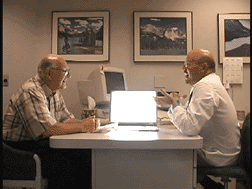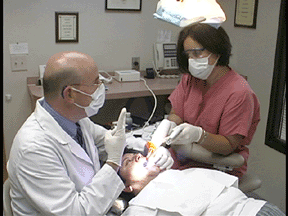|
 Despite
the lack of encouragement from those around him, who had never
heard of a deaf dentist, Lehfeldt went forward with his career
goals. He first went to Georgetown University where he experienced
some culture shock. "I had been a little sheltered in
my small England school, only 30 kids in my classes. At Georgetown
I experienced not only American culture shock but hearing
and deaf world culture shock as well." Lehfeldt had never
used sign language before, but took classes in American Sign
Language at Gallaudet University. Lehfeldt never attended
Gallaudet, put its close proximity to Georgetown gave him
enough exposure to American Sign Language that he was able
to pick it up. Despite
the lack of encouragement from those around him, who had never
heard of a deaf dentist, Lehfeldt went forward with his career
goals. He first went to Georgetown University where he experienced
some culture shock. "I had been a little sheltered in
my small England school, only 30 kids in my classes. At Georgetown
I experienced not only American culture shock but hearing
and deaf world culture shock as well." Lehfeldt had never
used sign language before, but took classes in American Sign
Language at Gallaudet University. Lehfeldt never attended
Gallaudet, put its close proximity to Georgetown gave him
enough exposure to American Sign Language that he was able
to pick it up.
After
receiving a bachelor's degree in chemistry and math at Georgetown,
Lehfeldt began applying to dental schools. He was fearful
that he would not be accepted because he was deaf, and did
not disclose his disability on his application materials.
However, he did tell them during interviews.
"I
had to take control of the situation right when I walked into
the interview," he explains, "The interview room
was dimly lit. The doctor would look like just a shadow with
the bright window behind him so I could not see him at all.
I knew that I would never get through the interview that way
So I just had to go in and rearrange the whole environment
at these interviews. I had to take control right away and
say, 'We need to switch places and close the blinds and turn
the light on because I can't hear well."
He was
accepted at the University of Maryland School of Dentistry
immediately after an interview with five faculty members;
one of which pulled him aside and notified him of his impending
acceptance.
"I
was floored. Here I had been hearing 'No' all my life and
this guy says to me, 'We want you here. We are going to accept
you." I'm glad he was able to tell me right away, it
put me at ease and let me know that I would be accepted there,"
said Lehfeldt. "They were all very open. They just said,
'How can we help you_ How can we make this work_'"
Lehfeldt
admits that he didn't always have the answers to that question.
"I had never gone to dental school before. I didn't know
how I was going to do everything. It was just a learn as I
go situation." For example, in his anatomy classes, he
was required to look at slides while the lights were dimmed
and the professor lectured while pointing to slides with a
red light pointer. He and his professor set up a system in
which the professor would show him the slides ahead of class.
The professor would speak first, then point to the slide.
During
his clinical years, Lehfeldt estimates that he spent double
to triple the amount of preparation time as the average student,
but did not have much trouble keeping up. He wishes now that
he would have utilized an interpreter and thus cut down on
the amount of off time he spent preparing on his own. He was
able to work out systems with the receptionists to aid him
in calling patients and being notified when patients had arrived.
After
finishing dental school, Lehfeldt worked in a practice with
another dentist in the Washington DC area for a few years,
then moved to Rochester, NY, which has the largest population
(82,000) of deaf individuals in the world. He currently works
in private practice at Elwood Dental Group with 8 other dentists
(all hearing) 2 days a week and works at a rural clinic that
provides care to migrant workers the other three days.
At his
practice, he treats both hearing and deaf patients. He does
the majority of communicating with patients up front, before
he even touches their teeth so he is able to lip read or sign
easier. Then, he sets up a communication system with them
so that if they are experiencing pain or need a break, they
can hold up one or two fingers to let him know. If he does
need to communicate with them during the procedure, he always
tries to remove his mask while speaking both for better communication
and as a show of respect to his patients. He says most patients
are pleasantly surprised by this because they have time up
front to understand and ask questions. He will sometimes barter
free dental services to interpreters to assist him in meetings
or other times when communication is particularly tough for
him.
His receptionist
takes calls for the practice, but he gives each of his patients
his email address so that they can communicate with him one-on-one.
"Email has been a great advancement for me," he
says, "my patients are always really surprised when I
give them my email address and then actually give them a personal
response to their emails. They seem to like that availability."
Lehfeldt
sees a great many advantages such as these that he is able
to bring to his patients. "I see that I can communicate
better with the migrant workers who are Spanish speaking.
Many of them have never been taught good oral hygiene because
no one took the time to really explain to them about how to
brush and how to care for your teeth. I am used to having
to be patient and struggling to communicate. I know how to
work with them without using words to make sure they understand."
 A
few years after working at his private practice, he was working
with patient Giselle Gonsolin, who is deaf and was searching
for a new career at the time. Gonsolin who was born in Bermuda,
moved with her family to Louisianna after she became deaf
at the age of two to take advantage of better schools for
her. She later moved to Rochester and took classes in accounting,
but was unable to find steady work. When she came into see
Lehfeldt for a dental appointment, she told him that she was
depressed about being unemployed. He suggested that she become
a dental assistant. She took his advice and attended Continental
Dental Assistant School in Rochester. Gonsolin was then hired
by Lehfeldt, and currently works with two of the dentists
in the practice and also does lab work. Gonsolin and Lehfeldt
can communicate well together using sign language, and she
also helps the hearing doctors work with both deaf and hearing
patients. She enjoys opportunities when she gets to interpret
for them. Gonsolin was voted Employee of the Year last year
by all the members of the practice. A
few years after working at his private practice, he was working
with patient Giselle Gonsolin, who is deaf and was searching
for a new career at the time. Gonsolin who was born in Bermuda,
moved with her family to Louisianna after she became deaf
at the age of two to take advantage of better schools for
her. She later moved to Rochester and took classes in accounting,
but was unable to find steady work. When she came into see
Lehfeldt for a dental appointment, she told him that she was
depressed about being unemployed. He suggested that she become
a dental assistant. She took his advice and attended Continental
Dental Assistant School in Rochester. Gonsolin was then hired
by Lehfeldt, and currently works with two of the dentists
in the practice and also does lab work. Gonsolin and Lehfeldt
can communicate well together using sign language, and she
also helps the hearing doctors work with both deaf and hearing
patients. She enjoys opportunities when she gets to interpret
for them. Gonsolin was voted Employee of the Year last year
by all the members of the practice.
Both Gonsolin
and Lehfeldt have found that in working in the field of dentistry
as professionals who are deaf they have been able to give
their patients quality care with excellent communication skills.
Lehfeldt says that "people think there will be a big
communication problem with a deaf dentist, but then they say,
'Well, this is the first time anyone's ever taken the time
to explain that too me.'"
|